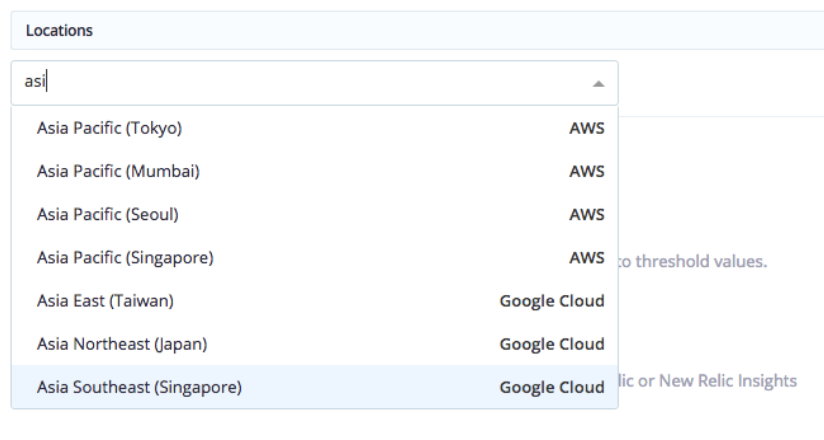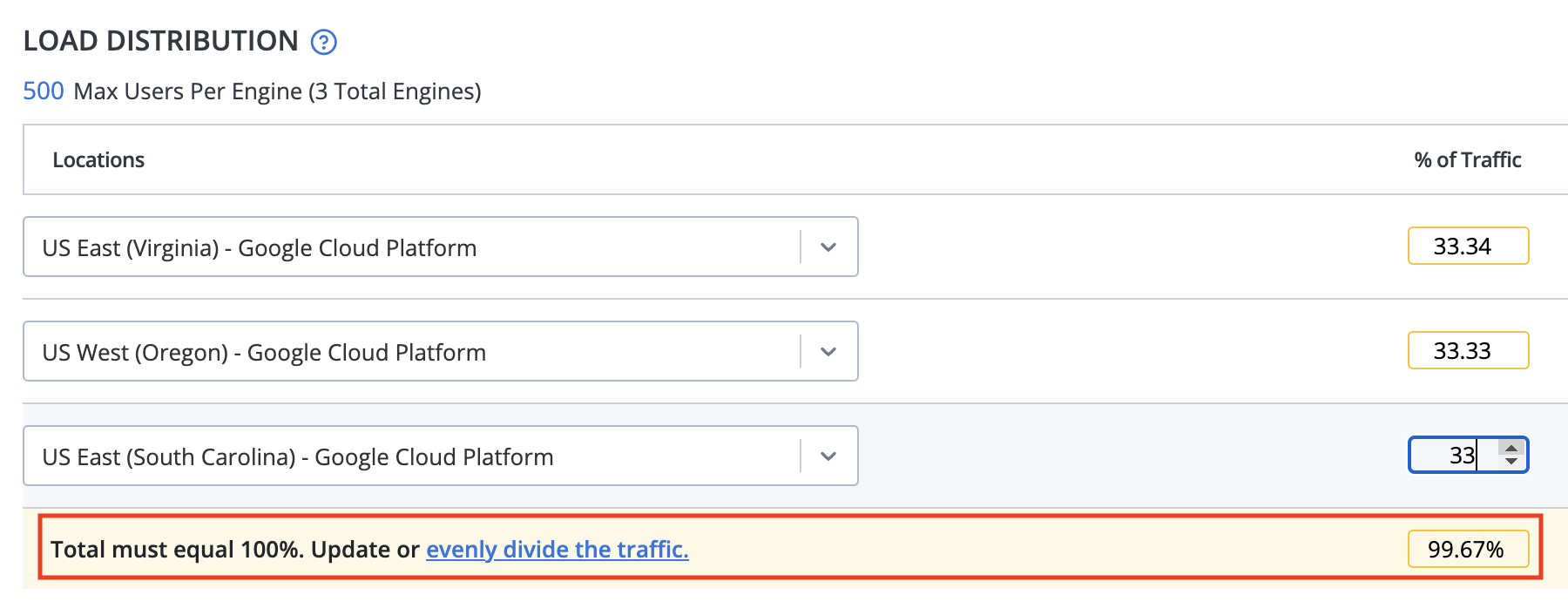Load distribution
BlazeMeter is a cloud-based service which lets you choose the geographical location that you wish to run the load from.
When you think of load testing, it is understood that you would have more than one user hitting the website. To get the best realistic results from your load test, you should mimic the actual real time environment where the end users would be using your website. Typically, your users are located throughout the world. You can load test your application in the same way.
BlazeMeter provides you with the infrastructure and ability to select your desired multiple geographical location from where you would like the load to be generated while you are performing load test against your application.
You can run the test from one location or distribute the load across multiple locations. This selection can be modified before each run. This means that you can run the same test several times and choose a different location each time.
You can also change the default ratio of users to engines or set the engine count manually in cases where you are not using the Total Users setting.
- Select a Location
- Select Multiple Locations
- Advantages of Generating Load from Multiple Geographic Locations
- How the Engine to Users Ratio Works
- How to Set a Load Origin Location in your BlazeMeter Load Test
- Locations You Can Generate Load From
Select a location
Follow these steps:
- In the Performance tab, open a test or create a new test.
- In the Configuration tab, scroll down to the Load Distribution section.
- In the Locations column, expand the drop-down menu to display the list of locations and make your selection.Start entering a location name to filter the list:

Select multiple locations
You can distribute your test Virtual Users load to multiple cloud locations. By default, the locations will be equally weighted.
Follow these steps:
- To add another location, click the + Add Location button. To delete a location, click the bin icon. Each time you click the + Add Location button, a new line will be added and the % of traffic will be re-calculated to evenly distribute the users. There is a limit of ten locations per single test. After adding a 10th engine, the + Add Location button will be grayed out. If your test requires more than ten locations, consider setting up a multi-test instead.
-
(Optional) To use multiple locations with a custom-weighted (unequal) distribution, make your edits in the % of Traffic field.
While you are editing, a message will display that reminds you that your numbers must add up to 100%. To go back to equal distribution, click evenly divide the traffic.
Advantages of generating load from multiple geographic locations
Here are some of the advantages of generating load from multiple geo-locations:
- Mimic Actual End user usage pattern
- Ability to generate unique data stream to effectively test Load Balancer or other components
- Ability to hit the server with unique request and test its processing power
- Ability to check the effective usage of application code for features like concurrency, caching, cookie, session etc.
- Ability to check the Memory leakage issues
- Ability to check the effective configuration of the Database server to handle an incoming request, process it, and send the correct response
- Maximum coverage of website usage with respect to different client network parameters
- Ability to check the fail-over capability of the server
- Ability to check the proper working of network architecture
- Ability to check for requirements for scalability of existing hardware resources in different geographical locations.
How the engine to users ratio works
BlazeMeter automatically calculates the number of engines you will need based on your entry in the Total Users field. The default ratio between users and engines is configured as part of your plan. In most cases, you do not need to alter this setting.
If your test is particularly resource intensive or you are running a JMeter test with multiple thread groups, you may want to change the ratio of users to engines.
Change the ratio of users to engines
Follow these steps:
- In the Performance tab, open a test or create a new test.
- In the Configuration tab, scroll down to the Load Distribution section.
- Click the number to the left of Max Users Per an Engine and enter a new value or drag the slider. BlazeMeter will automatically adjust the number of required engines.
Set the number of engines when total users is toggled off
If you have Total Users toggled off in your Load Configuration, you will need to set the number of engines for BlazeMeter to run your test on. The default is one but you can increase the number to the maximum allowed by your plan.
Follow these steps:
- In the Performance tab, open a test or create a new test.
- In the Configuration tab, scroll down to the Load Distribution section.
- Click the number of Total Engines and enter a new value or drag the slider. BlazeMeter will automatically adjust the number of required engines.
Use care with this setting, as the number of users your test creates will equal [users defined in your script] * [number of engines]
If this happens, go back and check the Total Engines slider. For example, you may have intended to run a 1-engine test, but the Total Engines setting may have accidentally been set to 2, especially if you are running a larger number of users (over 500).
To change your plan limit, click Get More to be taken to your Account Billing screen where you can see your plan, compare plans, or contact sales.
How to set a load origin location in your BlazeMeter load test
You can choose the specific geographic location from which you wish to run your load. This selection can be modified before each run, that way you can run the same test several times and each time choose a different location in the world. For more information, see Locations You Can Generate Load From.
Best practice for selecting load origin location in your BlazeMeter tests
- First, you should start with testing with the nearest location from the load locations available. Once you have run sufficient load tests and the results are in an acceptable range, select the farthest server and run the same test. Check the response times, see the network latency and perform any optimization required and rerun to verify the results
- You can run load from multiple locations simultaneously by creating multiple tests with different load origin locations and then scheduling these tests to run at a predefined time to check the load on the test servers.
- You can use the Multi Test feature to monitor and view the results from different geographic locations in one aggregated report.
- You can run load from multiple locations with multiple tests with different network emulation values for maximum coverage.
Locations you can generate load from
We currently provide the following locations:
Amazon Web Services (AWS) Locations:
- US East (Virginia)
- US East (Ohio)
- US West (North California)
- US West (Oregon)
- Canada (Central)
- EU West (Ireland)
- EU West (London)
- EU West (Paris)
- EU Central (Frankfurt)
- Asia Pacific (Tokyo)
- Asia Pacific (Mumbai)
- Asia Pacific (Seoul)
- Asia Pacific (Singapore)
- Asia Pacific (Sydney)
- South America (Sao Paulo)
Google Cloud Platform Locations:
- US East (Virginia)
- US East (South Carolina)
- US West (Oregon)
- US West (California)
- US Central (Iowa)
- Canada East (Montreal)
- EU West (London)
- EU West (Frankfurt)
- EU West (Belgium)
- EU West (Netherlands)
- Asia East (Taiwan)
- Asia Northeast (Japan)
- Asia Southeast (Singapore)
- Asia South (Mumbai)
- Australia (Sydney)
- Brazil (Sao Paulo)
- Japan (Osaka)
Microsoft Azure Locations:
- US East (Virginia)
- US East 2 (Virginia)
- US West (California)
- US West 2 (US West 2)
- US West Central (US West Central)
- US Central (Iowa)
- US North Central (Illinois)
- US South Central (Texas)
- Canada East (Quebec City)
- Canada Central (Toronto)
- EU West (Netherlands)
- EU North (Ireland)
- UK West (Cardiff)
- UK South (London)
- Japan East (Tokyo, Saitama)
- Japan West (Osaka)
- Korea Central (Seoul)
- Korea South (Busan)
- East Asia (Hong Kong)
- Southeast Asia (Singapore)
- Central India (Pune)
- West India (Mumbai)
- South India (Chennai)
- Australia East (New South Wales)
- Australia Southeast (Victoria)
- Brazil South (Sao Paulo)
Jump to next section:



